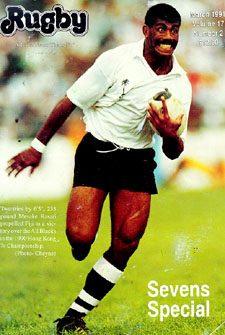 |
|
|---|---|
| Home- About Rugby7.com- Database- Tournaments | |

Using Video To Analyze Performance
There are a lot of people generating game statistics in rugby (both quantitative: # of scrums won & lost, etc., and qualitative: amount of "good ball," etc.). Sevens, however, offers us a unique opportunity to develop information in more detail than in fifteens.
The fact that there's only 7 players on the field, and the fact that games only last 14 minutes, means that most players are visible throughout the match and that multiple viewings of each match are not too time consuming and difficult.
On several occasions the Eagles have had the good fortune to have their matches videotaped.
The discussion that follows is reprinted from a 1988 article in Rugby, and is based on the tapes of the 1988 Hong Kong Sevens. These tapes represent 69 minutes of action (all but the first half of our first match, against Thailand. This is unfortunate for Kevin Higgins who scored his only two tries of the tournament in that half).
Situations
Figure 1 shows "traditional" statistics: number of set pieces and 2nd phase ball won, and also shows the relative frequency of each set piece. As I've been preaching for years, the kickoff is one of the most frequent set pieces in sevens, along with the scrum, and both need to be practiced in some detail.
Figure 1 indicates that, while we won the majority of our scrums, we didn't do as well as our opponents: we won 76% of our ball, whereas they won 86% of theirs.
The advantages that our height and jumping ability gave us is reflected by the fact that we did very well in both lineouts and short kickoffs.
Of particular interest is that at the pile-up (a non-ruck, non-maul situation, where several bodies are lying around a ball on the ground), we won only one of 11 balls. That kind of information should indicate that practice is needed to improve our performance at this situation.
As mentioned above, because of the shorter time/fewer players in sevens, it is possible to watch the tape several times and assess each player's individual performance.
I have taken a first crack at doing this with the individual players on the Eagles' Hong Kong squad--on offense, with the ball in their hands.
Figure 2 gives stats for 2 players of very distinct styles, Tommy Smith and Barry Williams. These data describe how each player got the ball, and what he did with it.
The data indicate, quantitatively, what those of us that know him are already aware of: that Tommy respects the value of possession and will almost always keep the ball alive for his teammates to use.
Tommy touched the ball 48 times and only turned it over twice (and one of those was a kick for touch)! Furthermore, he had a hand in 10 of the 12 tries we scored (the other two: Barry fielded a long kickoff and scored, and Mike Siano intercepted a line out throw in and fell over the line for a score).
Furthermore, he had 7 assists (gave the last or next-to-last pass), which represents more than half the tries we scored.
Tommy, however, didn't score any tries, and you can't win games without tries.
That brings us to the opposite type of ballplayer, Barry Williams. Barry's strength is scoring tries, and every time he gets the ball in space, he'll be looking to do that. Barry scored 6 of the 12 Eagle tries on the tape.
Figure 2 shows that Barry touched the ball only 15 times during the tournament, and scored 6 of those times, or 40%. It also shows that 7 times (47%) he turned the ball over. It seems amazing that 87% of the time Barry touched the ball, he either scored a try or gave the ball away.
My criteria were very stringent: they included kicks to touch, for example, as turnovers, as well as being pushed into touch after a long run, which happened to Barry at the one-foot line on one occasion. Furthermore, runners like Barry, by the very aggressiveness of their running style, will tend to turn the ball over more than their more conservative counterparts.
The obvious job for the coach, based on these statistics, is to find a way to get Barry to respect possession a little more without losing his desire to score.
I've done for all the Eagles on the Hong Kong team what I've shown for Tommy and Barry in Figure 2, and Figure 3 presents a summary of all this data. I invite you to look at it and come up with your own conclusions as to what is relevant, and, among other things, what areas of each player's play should be improved, etc.
One thing that struck me, for example, was that Kevin Higgins handled the ball less frequently (once every 4.9 minutes) than anyone else; given Kevin's offensive tools, we need to find ways for him to be handling the ball more often.
Viewing tapes of a fifteens match for the purposes of gathering statistics, although certainly valuable, can be very time-consuming and fatiguing, and less comprehensive: it's difficult to watch each person at every phase of the game, and it's difficult to know who's doing what inside those crowded rucks and mauls.
In sevens, on the other hand, virtually everything is exposed, and the experience is usually quite a rewarding one.
Any team that videotapes their game, and examines the tapes to chart statistics (or even to just look at individual plays), should be able to improve their play by doing so.
The next, and more difficult, challenge, is to figure out a way to quantitatively analyze aspects of players' performance other than what they do with the ball in their hands. This is left as an exercise for the reader.
Figure 1. Summary of Results when Contesting Possession
Data taken from AT&T's tapes of Eagles in Hong Kong: they include 69 minutes of sevens (the equivalent of 4.93 14-minute games), all but the first half v. Thailand.
a. First phase ball
--Our put in-- --Their put in-- --Total--
Set piece Good Tot # Good Tot # Good Tot # result result result
for us for us for us
Short KO 4 6 8 13 12 19 Long KO (to DO) 1 4 0 1 1 5 Long KO, no DO 0 1 1 1 2
Kick Offs (tot) 5 10 9 15 14 25 Set Scrums 13 17 2 14 15 31 Line Outs 3 3 3 6 6 9 Drop Outs 2 3 2 6 4 9
Set Pieces, ST 23 33 16 41 39 74 Percent: Won 70 % of ours; won 39% of theirs
Penalty Kicks (*) 15
Set Pieces, Tot 89
(*): In the case of penalty kicks, we were awarded 5 and scored directly from 2; our opponents were 4 out of 10.
b. Second phase ball
--We take in-- --They take in-- --Total--
Situation Good Tot # Good Tot # Good Tot # result result result
for us for us for us
Mauls 3 3 3 4 6 7 Rucks 0 0 0 0 0 0 Pile-Ups 0 4 1 7 1 11
2nd phase, Tot 3 7 4 11 8 18 Percent: Won 43 % of ours; won 36 % of theirs
c. Total possession contests
Possession
Contests, Tot 26 40 20 52 47 92 Percent: Won 65% of ours; won 38% of theirs
Avg # per 14-min. game:
Set Scrums: 6.3 Pile-Ups 2.2
Kickoffs: 5.1 Mauls 1.4
Penalty Kicks: 3.4 Rucks 0
Line Outs: 1.8
Drop Outs: 1.8
Total 1st phase: 8.1 Total 2nd phase 3.6
Figure 2. Offensive data: Tommy Smith and Barry Williams
Both played in all 69 minutes; Tommy at SH, Barry at W In that time period, 12 tries by us, 7 by opponents
Tommy Smith
24 times: received pass and gave pass
12 times: receive ball from scrum and gave pass
3 times: passed ball after taking tap at PK
2 times: received ball from LO and passed
2 times: received pass and kicked to touch (once at end of half ==> 1 turnover)
1 time: touched down for 22
1 time: touched down for 5-m scrum, but was end of game, ==> no turnover
1 time: picked ball off ground and gave pass 1 time: received pass and threw interception (turnover) 1 time: won DO to self and passed
Summary: handled ball 48 times (once every 1.4 minutes) 0 tries
19 links to 10 tries, including 7 assists 2 turnovers
Turnover rate: 4% Try rate: 0%
Barry Williams
6 times: received pass and lost ball at tackle (6 turnovers) 5 times: received pass and scored try
1 time: received Thai kickoff and scored try
1 time: received pass and kicked to touch
1 time: picked ball from ground and passed
1 time: picked ball from ground and kicked to touch (turnover)
Summary: handled ball 15 times (once every 4.6 minutes) 6 tries
0 links to 0 tries
7 turnovers
Turnover rate: 47% Try rate: 40%
Note: put-ins at scrum and throw-ins at line out not included as handling opportunities.
Turnover: anything, while the ball was in our possession, that resulted in its being recovered by, or put into play by, our opponents. (Includes kicks to touch, being tackled into touch, as turnovers.)
Link: anytime ball handled in try-scoring sequence; e.g. if one player handles twice in the sequence, there are 2 links to 1 try.
Assist: giving the last or next-to-last pass preceding a try.
Figure 3. Summary of Individual Statistics with Ball in Hand
Player Min. Pos(min) Handl.freq Tries Links to TO TO% #, min/# Assts #tries
Smith 69 SH (69) 48 1.4 0 7 19 10 2 4%
B. Williams 69 W (69) 15 4.6 6 0 0 0 7 47%
Higgins 69 H (69) 14 4.9 0 1 4 4 4 29%
Siano 69 THP(69) 29 2.4 2 1 7 4 5 17%
C.Wilkinson 62 FH (62) 27 2.3 0 3 10 7 6 22%
M.Williams 55 FH(7),C(48) 17 3.7 2 2 4 3 7 41%
J.Wilkinson 48 LHP(48) 17 2.8 1 3 6 5 1 6%
LaPorta 21 C (21) 5 4.2 1 0 1 1 1 20%
Poquette 21 LHP(21) 5 4.2 0 0 1 1 0 0%
Total 69 177 0.4 12 17 57 (12) 33 19%
[Columns: 1. Player name, 2. # minutes played, 3. Position played, (# minutes at that position), 4. # times handled, 5. # minutes per time handled, 6. Tries, 7. Assists, 8&9. Links (8) to #tries, 10. # turnovers, 11. % of times handled that a turnover was committed.
Copyright 1999-2025
